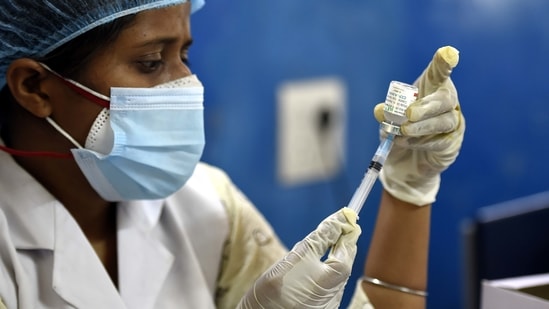Digital divide: More jabs administered in urban districts than in rural areas
District wise data provided on the Co-WIN website, analysed by Hindustan Times, shows that doses administered in urban districts were nearly 1.7 times those in rural districts as on May 13.
The Covid-19 vaccination drive, which was opened to all adults from May 1, has managed to cover significantly more ground in urban districts in India, data analysed from the Co-WIN dashboard shows, strengthening criticism that the digital-only process could be leaving out a large section of the rural population.

District wise data provided on the Co-WIN website, analysed by Hindustan Times, shows that doses administered in urban districts were nearly 1.7 times those in rural districts as on May 13.
While this divide has persisted in all phases of the vaccination drive – which initially opened for health care workers, followed by frontline workers and people above 60, and then those over the age of 45 – it has particularly widened since May 1, when all adults became eligible for doses. (See chart)
India allowed people above 60 to get doses from March 1, and those above 45 from April 1.
Also Read | Assam starts special Covid-19 vaccination drive for transgenders. It’s the first in India
As on May 13, the gap between per capital doses in urban compared to rural areas was the widest ever. To be sure, the divide between urban and rural areas has always been higher at the beginning of each phase and reduced over time, which is understandable.
In the first thirteen days of the first phase of vaccination – when only health care workers were being vaccinated -- the share of total doses administered in the largely urban districts (where only up to 40% population is rural) was 0.25% compared to 0.18% in rural districts (where more than 60% population is rural). This means that adjusted for their populations, urban areas administered 1.39 times the number of doses of their rural counterparts. The average of this ratio for these first 13 days was also around this number.
In the first thirteen days of the 2nd phase that started on March 1, the average of this ratio was 1.51. This average was 1.53 in the first thirteen days after April 1 and is 1.65 between May 1-13.
Anecdotal reports about people from cities travelling up to a 100km to rural areas in the state for a vaccine mean that the actual disparity may be higher with many of the doses in centres in rural areas actually being administered to people from neighbouring urban areas.
Also Read | The race to get vaccinated – Fastest finger first
This analysis is based on classification of districts into three broad regions based on share of rural population in them: urban districts or those with up to 40% rural population, mixed districts or those with 40%-60% rural population, and rural districts or those with over 60% rural population. Of the 755 districts on the Co-WIN dashboard, 65 are urban, 93 mixed, and 597 rural.
It isn’t just rural districts that have lagged compared to urban districts, but also the mixed ones, although to a lesser degree.
According to a government official who did not wish to be identified, the ultimate constraint is the availability of vaccines and not the Co-WIN platform itself. “There are nearly 30 lakh (three million) people registering every day. Since May 1, nearly seven crore (70 million) have registered. If we break down these numbers, with the number of doses being administered per day, then just 3 lakh (300,000) vaccines are being chased by all these registered. This means there are nearly 230 people clamouring for one dose.”
The official added that even within the urban population, this was likely to cause a situation where people cannot access the vaccine. “The total monthly production of vaccines in India at present is seven crores (70 million), six for Covishield and one by Covaxin, that means at most 23-lakh (2.3 million) people can be vaccinated in one day.”
Defending the government’s decision to make registration mandatory, the official said that without registration, and with walk-ins, the situation could turn worse. “How would the centres manage the crowds if walk-ins were allowed,” the official said.
The difference in terms of total doses administered naturally extends to share of people who have received at least one dose. Urban districts, which are home to 13.6% of India’s population, accounted for 19.7% of first doses administered until May 13. Mixed districts, home to 13.6% of population, accounted for just 15.4% of first doses in the same time period (and at least some of these surely went to people from urban areas).
Rural districts, home to 73% of India’s population, accounted for only 64.9% of first doses. In this case too, at least some went to people from urban areas.
Development economist and IIT professor Reetika Khera said: “The fact that urbanised districts received more than their proportionate share of vaccines does not adequately capture how the rural population may have been squeezed out. Even in the ‘rural districts’, there is no guarantee that doses have been administered to people in rural areas.”
She added that a more serious concern is the combination of the lack of doses, vaccination being open to all over 18, and the de-facto removal of walk-in appointments. “This means that the most vulnerable - economically, socially and health-wise - populations will suffer,” she said.
Get Current Updates on India News, Lok Sabha Election 2024 live, Infosys Q4 Results Live, Elections 2024, Election 2024 Date along with Latest News and Top Headlines from India and around the world.





